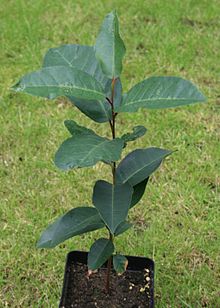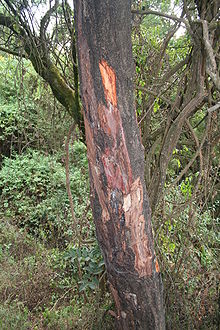- Prunus africana
-
Prunus africana 
Conservation status Scientific classification 
Kingdom: Plantae clade: Angiosperms clade: Eudicots clade: Rosids Order: Rosales Family: Rosaceae Genus: Prunus Subgenus: Cerasus Section: Laurocerasus Species: P. africana Binomial name Prunus africana
(Hook.f.) KalkmanSynonyms[1] Pygeum africanum Hook.f.
Prunus africana, or Red Stinkwood (see the names, below, for more), is an evergreen tree native to the montane regions of Sub-Saharan Africa and the Islands of Madagascar, Sao Tome, Fernando Po and Grande Comore at about 900–3400 m. of altitude. The mature tree is 10–25 m. high, open-branched and often pendulous in forest, shorter and with a round crown of 10–20 m. diameter in grassland. It requires a moist climate, 900–3400 mm annual rainfall, and is moderately frost-tolerant.[2][3][4][5][6][7]
The bark is black to brown, corrugated or fissured and scaly, fissuring in a characteristic rectangular pattern. The leaves are alternate, simple, long (8–20 cm.), elliptic, bluntly or acutely pointed, glabrous and dark green above, pale green below, with mildly serrate margins. A central vein is depressed on top, prominent on the bottom. The 2-cm petiole is pink or red. The flowers are androgynous, 10-20 stamens, insect-pollinated, 3–8 cm., greenish white or buff, and are distributed in 70-mm axillary racemes. The plant flowers October through May. The fruit is red to brown, 7–13 mm., wider than long, two-lobed with a seed in each lobe. It grows in bunches ripening September through November, several months after pollination.
Contents
Ecology
As with other members of the genus Prunus, Prunus africana possesses extrafloral nectaries that provide anti-herbivore insects with a nutrient source in return for protecting the foliage.
The fruit is too bitter to be of interest to man; however, it is a favored food supply for many animals, who spread the seeds. Dian Fossey reports of the Mountain Gorilla:[8] "The northwestern slopes of Visoke offered several ridges of Pygeum africanum .... The fruits of this tree are highly favored by gorillas." East African Mammals reports that stands of Pygeum are the habitat of the rare Carruther's Mountain Squirrel and asserts that "This forest type tends to have a rather broken canopy with many trees smothered in climbers and dense tangles of undergrowth."[9]
It is currently protected under appendix II of CITES.[10]Uses
Traditionally used for fevers, malaria, wound dressing, arrow poison, stomach pain, purgative, kidney disease, appetite stimulant, gonorrhoea, and insanity.[11]
An extract, pygeum, an herbal remedy prepared from the bark of Prunus africana, is used to treat a benign prostatic hyperplasia (BPH)[12] and has shown promise in treating prostate cancer in mice and in vitro.[13] [14] The collection of mature bark for this purpose and for other medical uses has resulted in the species becoming endangered.[15][16] Prunus africana continues to be taken from the wild. Plantecam Medicam deserves credit for attempting sustainable bark harvesting by removing opposing quarters of trunk bark rather than girdling the trees. However, quotas have been awarded by the Forestry Department without adequate forest inventories[17] due to some harvesters, spurred on by the high price per kilogram of bark, removing too much of the bark in an unsustainable manner. In the 1990s it was estimated that 35,000 debarked trees were being processed annually. The growing demand for the bark has led to the cultivation of the tree for its medicinal uses.[5]
The timber is a hardwood employed in the manufacture of axe and hoe handles, utensils, wagons, floors, chopping blocks, carving, bridge decks and furniture. The wood is tough, heavy, straight-grained and pink, with a pungent bitter-almond smell when first cut, turning mahogony and odorless later.[6]
Discovery and classification
The name of the remedy, pygeum, comes from the name of the plant, which was discovered to botany by Gustav Mann during his now famous first European exploration of the Cameroon Range, with Richard Francis Burton and Alfred Saker, in 1861. A letter from Mann to the Linnean Society of London, read by William Jackson Hooker, then Director of the Royal Botanic Gardens, Kew, on June 5, 1862, describes the naming of the peaks of the Cameroon Range (such as Mount Victoria, later Mount Cameroon[18]) and the collection of specimens there.[19] The latter were shipped back to Kew for classification, which was duly performed by Hooker and his son, Joseph Dalton Hooker, who had the responsibility of publishing them, as William died in 1865.
When the publication came out[20] the Hookers had named the plant Pygeum africanum, followed by the designation "n. sp.", an abbreviation for nova species. The habitat is listed as "Cameroons Mountains, alt. 7000-7500 feet", which was above the tropical forest and in the alpine grasslands. Hooker notes that another specimen had been "gathered in tropical Eastern Africa" at 3000 feet by Dr. Kirk on an expedition of David Livingstone.
The first publication of the synonym in 1864 had been preceded by publication of the bare name in 1863 in a book by Richard Francis Burton.[21] Evidently Hooker had already made the contents of J. Proc. Linn. Soc., Bot. 7 for 1864 available to some, as Burton mentions the volume and Mann's letter in 1863.[22]
Hooker gives scant hint of why he chose "pygeum"; however, what he does say indicates it was common knowledge among botanists. Kirk's specimen fruit was "a much depressed sphere." By this he undoubtedly meant to reference Joseph Gaertner's genus, Pygeum Gaertn.,[23] which innovates pygeum[24] from a Greek word, πυγή, "rump, buttock", because the two lobes of the fruit resemble the human gluteus maximus muscles.[25]
In 1965 Cornelis Kalkman moved Pygeum to Prunus and this classification has the authority for now.[26] However, a recent cladistic study notes of Pygeum: "its relationships to Prunus remain to be tested by molecular cladistics."[27]
Names
Prunus africana also goes by the following common names; Pygeum, Iron Wood, (Red) Stinkwood, African Plum, African Prune, African Cherry, Bitter Almond. In other languages where it grows it is known as; in Amharic 'tikur inchet', in Chagga 'Mkonde-konde', in Kikuyu 'Muiri', in Ganda 'Entasesa'or 'Ngwabuzito', in Xhosa 'uMkakase', in Zulu 'Inyazangoma-elimnyama' and in Afrikaans 'Rooistinkhout'.
Palaeobotanic evidence
A 1994/1995 study published in 1997 by Marchant and Taylor did a pollen analysis on and radiocarbon dated two core samples from montane Mubindi Swamp in Uganda.[28] The swamp is a catchment at 2100 m. altitude between mountain ridges. It is a "moist lower montane forest" in Bwindi Forest National Park. The investigators found that montane Prunus, represented by currently growing Prunus africana, has been in the catchment continuously since their Pollen Zone MB6.1, dated approximately 43000-33000 ybp.
References
- ^ "Sorting Prunus Names". Multilingual Multiscript Plant Name Database. http://www.ars-grin.gov/misc/mmpnd/Prunus_Pt1.html. Retrieved November 3, 2010.
- ^ U. S. Department of Agriculture (USDA). "Prunus africana (Hook.f.) Kalkman". Germplasm Resources Information Network (GRIN) Taxonomy for Plants. http://www.ars-grin.gov/cgi-bin/npgs/html/taxon.pl?29828.
- ^ U. S. Department of Agriculture (USDA). "Pygeum africanum Hook.f.". Germplasm Resources Information Network (GRIN) Taxonomy for Plants. http://www.ars-grin.gov/cgi-bin/npgs/html/taxon.pl?30392.
- ^ Dharani, Najma (2002). Field Guide to Common Trees and Shrubs of East Africa. New Holland. pp. page 150. ISBN 1868726401. Previewable Google Books.
- ^ a b Cunningham, A.B.; Mbenkum, F.T. (May 1993). "Sustainability of harvesting Prunus africana bark in Cameroon: A medicinal plant in international trade" (pdf). People and Plants working papers. Division of Ecological Sciences, UNESCO. http://peopleandplants.org/whatweproduce/Workingpapers/pdf/wp2.pdf.
- ^ a b World Health Organization, Inc. NetLibrary (2002). WHO Monographs on Selected Medicinal Plants: Volume 2. Geneva: World Health Organization. pp. page 246. ISBN 9241545372. Previewable Google Books.
- ^ Nonjinge, Siyabulela (October 2006). "Prunus africana (Hook.f.) Kalkman". PlantZAfrica.com. South African National Biodiversity Institute. http://www.plantzafrica.com/plantnop/prunusafri.htm.
- ^ Fossey, Dian (2000). Gorillas in the Mist. Houghton Mifflin Books. pp. page 146. ISBN 061808360X.
- ^ Kingdon, Jonathan (1984). East African Mammals: an Atlas of Evolution in Africa: Volume IIB. Chicago: University of Chicago Press. pp. page 389. ISBN 0226437183.
- ^ http://www.cites.org/eng/app/e-appendices.pdf
- ^ Stewart KM."The African cherry (Prunus africana): can lessons be learned from an over-exploited medicinal tree?." [Review] Journal of Ethnopharmacology. 89(1):3-13, 2003 Nov.
- ^ Edgar AD. Levin R. Constantinou CE. Denis L. "A critical review of the pharmacology of the plant extract of Pygeum africanum in the treatment of LUTS. [Review] [42 refs] Neurourology & Urodynamics. 26(4):458-63; discussion 464, 2007.
- ^ Shenouda NS. Sakla MS. Newton LG. Besch-Williford C. Greenberg NM. MacDonald RS. Lubahn DB."Phytosterol Pygeum africanum regulates prostate cancer in vitro and in vivo." Endocrine. 31(1):72-81, 2007 Feb.
- ^ Medicinal plants on verge of extinction – environment – 10 January 2009 – New Scientist
- ^ http://www.iucnredlist.org/apps/redlist/details/33631/0
- ^ "Africa's Medicine Tree Facing Extinction From Greed, Corruption". VOANews. 22 May 2006. http://www.voanews.com/english/news/a-13-2006-05-22-voa24.html. Retrieved 20 January 2011.
- ^ http://www.peopleandplants.org/storage/working-papers/wp2.pdf
- ^ The British names did not survive the transfer of Cameroon to Germany in 1884 and now are nearly unknown.
- ^ Hooker, Sir W.J. (1864). "Letter from Mr. G. Mann, Government Botanist, describing his Expedition to the Cameroon Mountains". Journal of the Proceedings of the Linnean Society: Botany VII: pages 1–13. http://www.botanicus.org/page/166680.
- ^ Hooker, J.D. (1864). "On the Plants of the Temperate Regions of the Cameroons Mountains and Islands in the Bight of Benin; collected by Mr. Gustav Mann, Government Botanist". Journal of the Proceedings of the Linnean Society: Botany VII: pages 191–192. http://www.botanicus.org/page/166680. The article occupies pages 171–240. The botanical abbreviation for this publication is J. Proc. Linn. Soc., Bot.
- ^ Hooker, J.D. (1863). "Enumeration of the Mountain Flowering Plants and Ferns Collected by M. Gustav Mann, Government Botanist, during his various ascents of the Cameroons Mountains, of Clarence Peak, Fernando Po, and of the Peak of San thomé". Abeokuta and the Camaroons Mountains: An Exploration: Appendix III. London: Tonsley Brothers. pp. 270–277.
- ^ Page 47, first note.
- ^ U. S. Department of Agriculture (USDA). "Pygeum Gaertn.". Germplasm Resources Information Network (GRIN) Taxonomy for Plants. http://www.ars-grin.gov/cgi-bin/npgs/html/genus.pl?16198.
- ^ See under De Fructibus et Seminibus Plantarum. The edition is the 1788.
- ^ Quattrocchi, Umberto (2000). CRC World Dictionary of Plant Names: Common Names, Scientific Names, Eponyms: Volume III M-Q. CRC Press. ISBN 0849326737. Previewable Google Books.
- ^ Kalkman, Cornelis. "The Old World Species of Prunus subg. Laurocerasus including those formerly referred to as Pygeum". Blumea 13: 1–115. The specification is Blumea 13:33.
- ^ Bortiri, Esteban; Oh, Sang-Hun; Gao, Fang-You; Potter, Dan (2002). "The Phylogenetic Utility Of Nucleotide Sequences Of SORBITOL 6-PHOSPHATE DEHYDROGENASE In Prunus (Rosaceae)". American Journal of Botany 89 (11): 1697–1708. doi:10.3732/ajb.89.10.1697. http://www.amjbot.org/cgi/reprint/89/10/1697.pdf.
- ^ Marchant, Robert; Taylor, David (1997). "Late Pleistocene and Holocene History at Mubwindi Swamp, Southwest Uganda". Quaternary Research 47 (3): 316–328. doi:10.1006/qres.1997.1887. http://www.york.ac.uk/res/kite/people/marchant/RAM%20PDFs/QR%201997.pdf.
Bibliography
- Hall, J.B.; Sinclair, Fergus L; O'Brien, Eileen M. (2000). Prunus Africana – A Monograph. Bangor: University of Wales. ISBN 1842200488.
External links
- Dailey, Bryan W.; Fernandes, Erick C.M. "The Effect of Ecological Conditions on Density and Growth of Prunus africana Seedlings in Madagascar". Cornell University. http://www.css.cornell.edu/research/prunus/.
- WWF. "Prunus africana" (pdf). http://www.wwf.org.uk/filelibrary/pdf/pafricana.pdf.
- Prunus africana in West African plants - A Photo Guide.
Categories:- IUCN Red List vulnerable species
- Afromontane
- Prunus
- Flora of Madagascar
- Flora of South Africa
- Trees of Africa
- Medicinal plants
- Vulnerable plants
Wikimedia Foundation. 2010.



